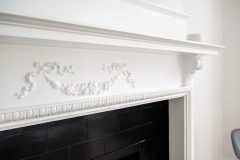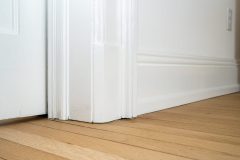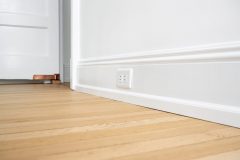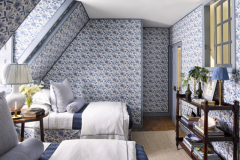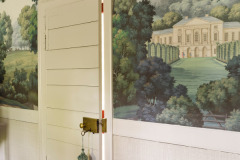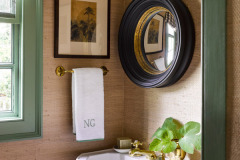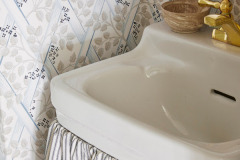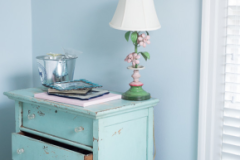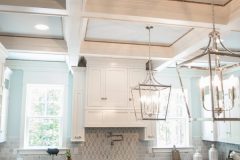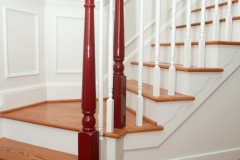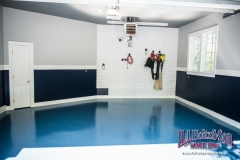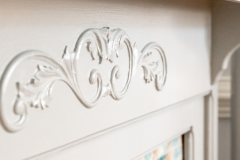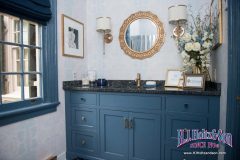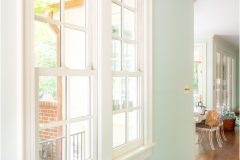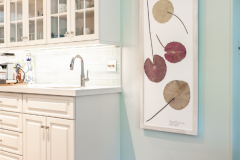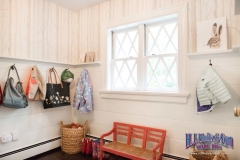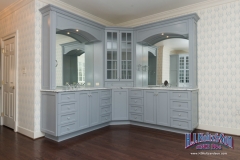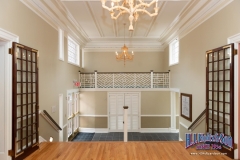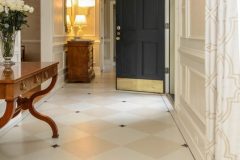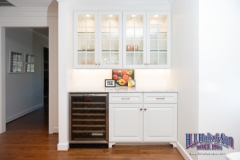
by HJ HOLTZ | Nov 14, 2023 | Residential Painting, Employees
Fredy Vigil came to H.J. Holtz & Son 10 years ago at the suggestion of his friend Juan Villanueva. Both are still with the company.
“He told me there was a lot of work here, and everyone was treated well,” Vigil says.
Vigil already had plenty of experience; he had been working as a painter for nearly 10 years when he switched employers. He says the most compelling reason offered by Villanueva was the assurance that at H.J. Holtz & Son, he wouldn’t face random days off without pay because of erratic work load. Instead, he would be guaranteed steady work.
Once he joined the Holtz & Son team, Vigil spent a few years learning the Holtz method, then became a foreman, leading project teams. He enjoys that role, he says, because he can run the job using his approach, which includes plenty of communication.
“At the end of the work day, I let everyone know what we’re going to do the next day,” he says. “That way, they know what to expect.”
Vigil has also enjoyed the chance to develop his painting skills. He is now one of the Holtz painting team members with extensive experience in working with the Fine Paints of Europe (FPE) product line. When painting with FPE coatings, the environment has to be carefully controlled – to prevent dust and other particulates from marring the surface – and the application has to be deliberate and precise.
“I liked the challenge of learning something new,” Vigil says of working with FPE, adding that he enjoys talking with people about that paint line. “We have to educate customers about what’s needed.”
When he’s not in a customer’s home, Vigil can often be found in the spray booth, an enclosed space where furniture and other objects are painted in a climate-controlled environment. “I really like being in the booth, because when I finish, I can see the good quality of the paint job,” he says. “And it’s nice to be on my own sometimes.”
Vigil also appreciates the family atmosphere of the company, noting that he was able to get to know current president Rick Holtz’s parents and sister when they were working with the company. “That makes me want to stay,” he says.
Happy 10th anniversary, Fredy!
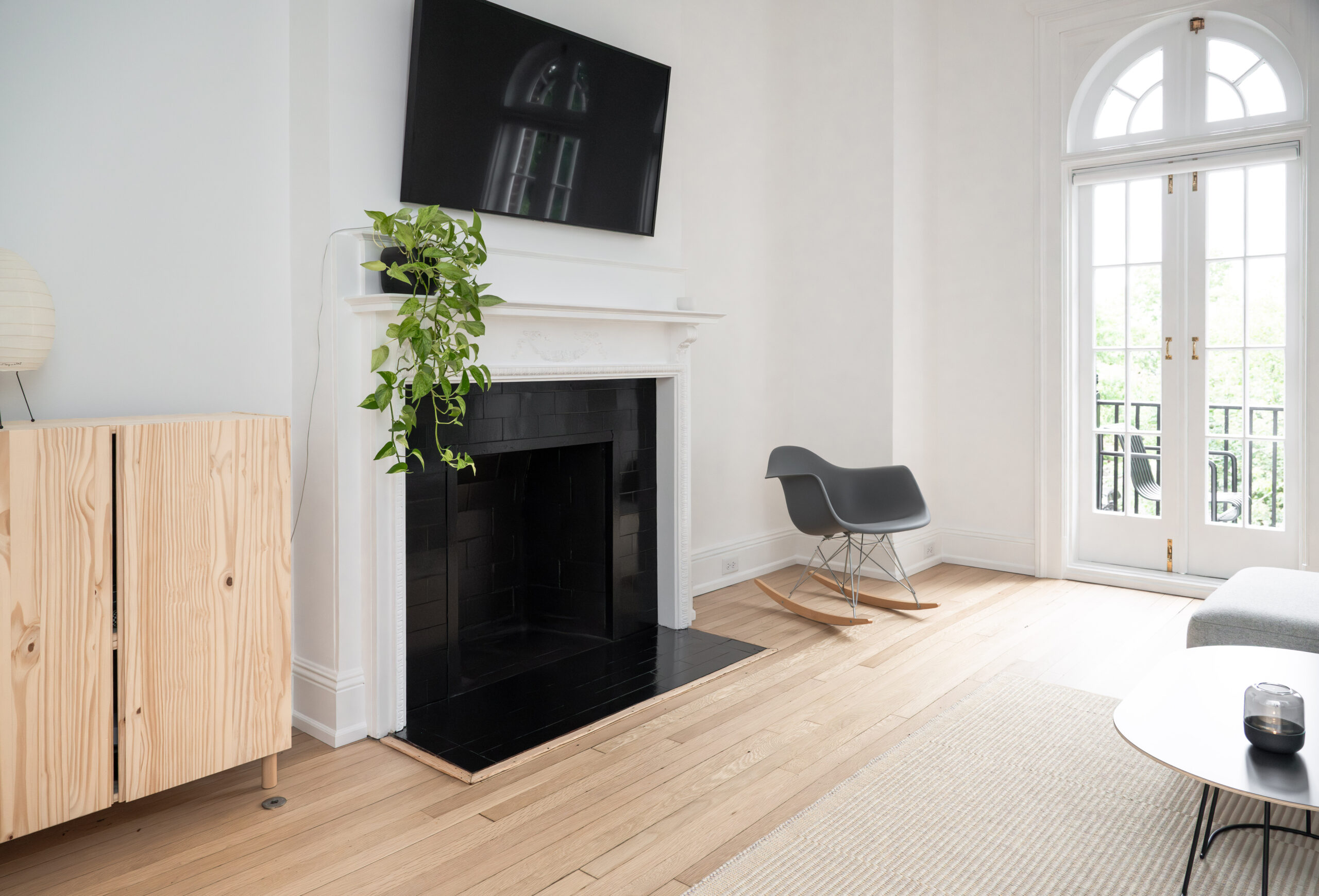
by HJ HOLTZ | Oct 10, 2023 | Client Work, Carpentry Services, Residential Painting
Kristen Ziegler wanted to avoid making the same mistakes twice.
In her first home renovation, she hired H.J. Holtz & Son to paint the house’s exterior after the painter who worked on the interior retired. She knew of the company’s high-end reputation, but soon found the craftsmanship and attention brought by the Holtz team to be worth any added expense.
So it was an easy decision for Ziegler to turn to Holtz & Son to help her renovate her new residence, a condominium in a 1914 apartment building. The original intent of the building was intact, but Ziegler wanted to restore the space with historical accuracy. “My first home was also my first renovation; I wasted some time and money in the learning process to get things right,” she says. “This time, I knew how to do things properly. It’s so hard: you don’t know what you don’t know.”
Painting the walls would be simple enough, Ziegler knew. The challenges were in the space’s woodwork. Trim around windows and doors was buried under layers of old paint. Crown molding at the ceiling wasn’t original to the apartment. And the baseboards were clearly also replacements; they were nearly two inches taller than the original baseboards in the building’s shared stairwell.
Working on a tight timeline, so Ziegler and her husband didn’t have to find a place to live between the sale of their previous home and moving into the new condo, the Holtz painting and carpentry divisions fabricated and painted new historically accurate baseboards, sanded and repainted all the home’s trim, and replastered and painted the walls after the inauthentic crown molding was removed. Later, after the couple had moved in, the Holtz team stripped and repainted exterior balcony French doors and painted the living room fireplace.
“The Holtz team was able to figure everything out – all the different parts – without me having to manage it,” Ziegler says. “They see other things that need attention and go above and beyond to make sure it’s complete. No detail is left unaddressed.”
As founder and principal of Minima – a firm that specializes in helping people declutter, organize, and redesign their spaces – Ziegler has an eye for detail. She credits Holtz craftsman Ricky Reid for working diligently to ensure that the new baseboards were aligned perfectly. “There are no straight walls here,” she says. “He got the trim to look straight and have the shadows look right. It was double the cost it could have been, but I’m so glad I did it.”
Ziegler is pleased with the finished project and even the process of getting there.
“I’m not an easygoing person, especially when it comes to renovations, but I’m kind,” she says. “I could tell they appreciated that, and they never got upset with me over my high standards. There’s no drama [with the Holtz team]; they show up on time and solve problems. They take pride in what they do.
“As a business owner, I value really strong customer service and really strong quality of service,” she adds. “I feel like they share those same principles, which brings peace of mind during complex projects.”
Find Minima at www.minimaonline.com
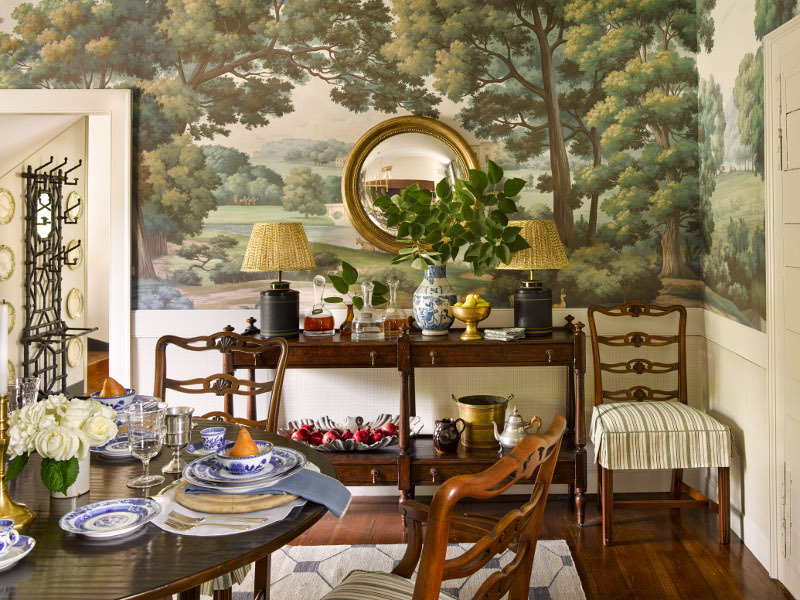
by HJ HOLTZ | Apr 24, 2023 | Carpentry Services, Residential Painting
Visitors to Colonial Williamsburg expect to see history interpreters in period-appropriate attire, craftspeople demonstrating skills essential to the era, and residences that show how Colonial Americans lived. But on certain days this year, they can also see how nationally known designer Heather Chadduck Hillegas brought Williamsburg’s oldest house – the Nelson-Galt House – into the twenty-first century as a showhouse and her home away from home.
And H.J. Holtz & Son was a partner and sponsor of the project.
Colonial Williamsburg’s Designer in Residence program is a collaborative initiative established by WILLIAMSBURG, the licensing brand of Colonial Williamsburg. The effort launched in 2019, when the first Designer in Residence, Anthony Baratta, redecorated the eighteenth-century Palmer House. As the second Designer in Residence home, the Nelson-Galt House, parts of which date to 1695, opened its doors for tours in December 2022.
The Designer in Residence program was conceived with twin goals: to show visitors how an older home’s history can coexist with modern-day style, and to showcase the traditionally inspired decor – furniture, paint, and wallpaper – that the WILLIAMSBURG brand has created with business partners.
“How do you make tradition and today work together?” posits Liza Gusler, associate director for WILLIAMSBURG Licensing. “One of our challenges now is to show people that eighteenth-century design is still relevant; it can be inviting and comfortable for a family to live in today.”
Using its extensive archives, WILLIAMSBURG has partnered with Benjamin Moore, Schumacher, Paul Montgomery, and Adelphi Paper Hangings on proprietary paint colors, fabrics, and wallpaper. Inspiration comes from archaeological finds, rare books and prints depicting scenes of the time period, and historic buildings. A 1750s silk gown worn by Martha Dandridge Custis Washington, who married George Washington in 1759, inspired the new Dandridge Damask by Schumacher.
While much of the work on the interior of the Nelson-Galt house was handled by Colonial Williamsburg’s staff – “We have to follow stringent strictures with our preservation team about what we can do and what we can’t do,” Gusler says – H.J. Holtz & Son wallpaper craftspeople were hired to install all the wallpaper selected by Hillegas.
“It’s a compliment to Holtz’s reputation when I share that it was sort of a command from our facilities and maintenance vice president [that we hire Holtz],” Gusler says. “The team could not have been nicer; they were very professional.”
The team’s job wasn’t small.
In the living room, the team hung a WILLIAMSBURG Kensington Whitework mural by Paul Montgomery, which was inspired by a pair of late seventeenth-century embroidered curtains in Colonial Williamsburg’s collection. In the dining room, the team installed a panoramic Paul Montgomery mural, Regency Views, wrapping it around three walls with multiple interruptions caused by entryways and windows. A first-floor hallway and adjacent powder room feature a custom iteration of WILLIAMSBURG Jefferson Trellis by Adelphi Paper Hangings. Adelphi crafts papers in the eighteenth-century manner, using a separate block to print each color.
On the second floor of the house’s annex, the hallway and a bathroom sport a modern Kumano Jute covering in Putty from Schumacher. Upstairs in the original house, the blue-and-white twin bedroom showcases Lafayette Botanical, a new WILLIAMSBURG Shumacher chintz pattern, which covers the walls as well as headboards and bed frames. A nearby second-floor bathroom is papered in Front Waltz in Sage by Schumacher.
As the largest living history museum in the country, Colonial Williamsburg takes its mission of bringing history to life, Gusler says.
“We think the Nelson-Galt House is a good opportunity to showcase the WILLIAMSBURG brand and help people understand we are still relevant today,” Gusler says. “We are so thankful for our partners and sponsors, including H.J. Holtz & Son.”
To purchase tickets for upcoming tour dates in the Nelson-Galt House, visit https://www.colonialwilliamsburg.org/events/tour-designer-in-residence/. The sale of WILLIAMSBURG products supports Colonial Williamsburg’s educational and preservation mission.
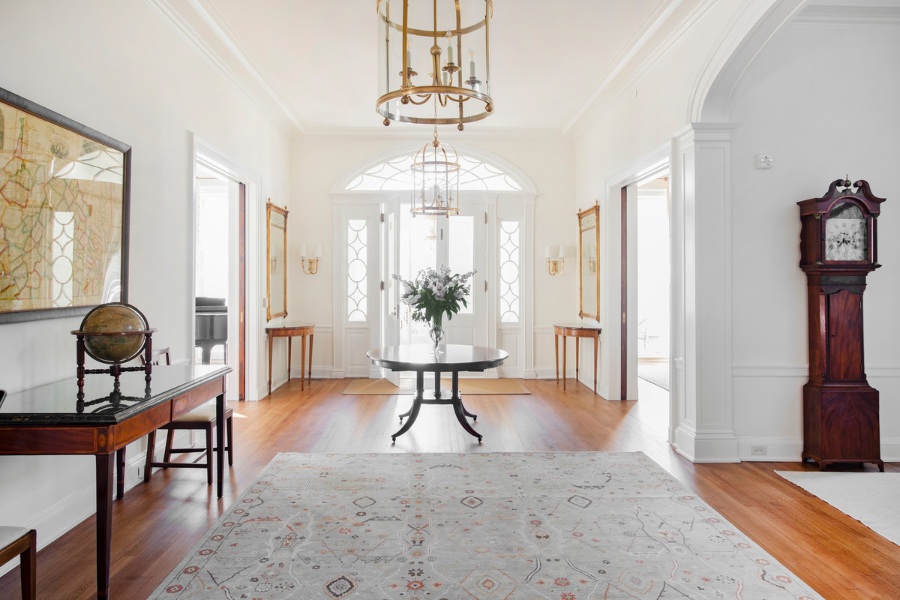
by HJ HOLTZ | Apr 5, 2023 | Carpentry Services, Residential Painting
Photo courtesy of Todd Wright
The homes presented in the Garden Club of Virginia’s 2023 Historic Garden Week share many characteristics: they have elegant spaces, they have carefully designed plantings, and they are impeccably maintained, inside and out.
H.J. Holtz & Son is proud to have helped numerous homeowners through the years – including two on this year’s tour – prepare their homes for the hundreds of HGW ticket-holders who come every spring to see not only their gardens, but also their homes. Holtz craftsmanship will also be on display this year in Charlottesville at Carr’s Hill, the residence of the president of the University of Virginia.
“We know our clients want to show their homes at their best every day,” says company president Rick Holtz. “Garden Week takes that up a notch, because these are public tours.”
The origins of Historic Garden Week date to 1927, when the Garden Club of Virginia hosted a flower show to raise money to save trees planted by Thomas Jefferson at his mountaintop home of Monticello. That first effort netted $7,000 – the equivalent to roughly $117,000 today. In 1928, the club raised money to help save Kenmore, the Fredericksburg-area home of Betty Washington Lewis, George Washington’s sister. In 1929, multiple houses and gardens were opened for a “pilgrimage,” with ticket prices going to fund restorations of historic properties and gardens throughout the state. This year’s Garden Week comprises 29 tours organized and hosted by members of clubs from Virginia Beach to Roanoke, from Martinsville to Middleburg.
Richmond, as in years past, has three tour days: April 18, 19, and 20. Tuesday’s tour, in the Westhampton neighborhood, includes 6407 Roselawn, where the Holtz team has assisted with painting and carpentry work. Thursday’s tour, along Three Chopt Road, includes 6207 Three Chopt, another property where Holtz craftspeople have completed projects.
Company president Holtz says he’s always pleased when a client reaches out for assistance prior to Garden Week. “It’s usually someone we’ve worked with in the past, who knows we can come in for touch-ups,” he says. “Sometimes, people will use the fact that their home is going to be on tour as a reason to do a project they’ve been putting off, like painting exterior trim or shutters, or the front door. Everyone wants their home to look good as people are walking up to the entrance.”
It’s common for homeowners to think about improvements prior to big life events, such as a wedding, graduation, retirement party, or the birth of a child. Rick Holtz advises those considering fresh painting or wall coverings as well as carpentry repair – which is managed by the in-house Holtz carpenters – to reach out well in advance of the special occasion, so there’s ample time to complete the project.
“You don’t want to rush into making decisions about color or décor,” he notes. “From our years in business, we know that a selected paint color, once it’s on the wall, may appear to be a different hue, based on the way the light is hitting it. We all want time to make sure that the final project is done to everyone’s satisfaction.”
For more information about the 2023 Historic Garden Week, visit vagardenweek.org. Tickets are $50 per day if purchased in advance; $60 per day at the tour headquarters.
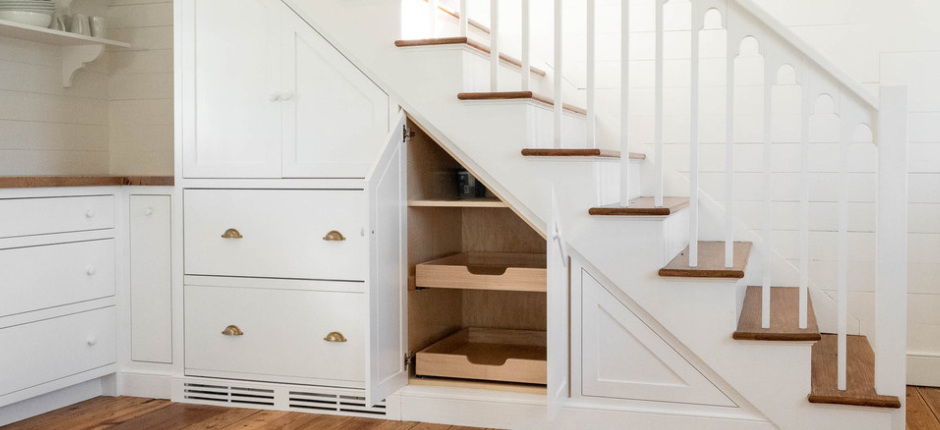
by HJ HOLTZ | Mar 15, 2023 | Carpentry Services, Residential Painting
Lizzie Cox’s clients knew they wanted to revitalize their comfortable river place … but not too much.
“The key theme throughout was to maintain the integrity of the old charm of the cottage,” says Cox, principal of Lizzie Cox Interiors in Richmond. “We wanted to update and refresh it without losing character.”
Cox recommended H.J. Holtz & Son to the client after having worked with Holtz on prior projects. She knew the team could handle the many tasks involved – and with the right touch.
“Because our goal was to make the house feel like it had not been updated, we did not want people to notice any major changes,” she says. “Holtz was definitely the right team for the job because they always listen to what the clients want.”
The interior project included painting the first floor’s walls, as well as redoing the floors both on the main level and upstairs. The original heart pine floors were refinished before they were painted, but were finished gently, both with stain and paint, to allow their history to show.
In addition to the painting, Holtz carpentry craftspeople patched stair boards, and even designed and fabricated a new stair banister. “We worked together to come up with a charming design, and they executed it perfectly,” Cox says. “It feels like it’s been there forever.”
The cottage was painted with Benjamin Moore Simply White, Cox says, because it has no undertone and looks good in all types of light exposures.
“It was really important that the painting not be so perfect,” she says, explaining that the homeowners really wanted to maintain the cozy, comfortable feel of a house that had been in their family for some time. “Because of [Holtz’s] experience with faux finishes and because they are such professional painters, they were able to get it just right.”
Despite the “normal” hiccups that come with any renovation project, Cox says, the update went very well. And working with the Holtz team makes her job easier, too.
“I know they’re going to get the job done from start to finish, and I don’t have to check in with them all the time,” she says. “They own their projects and put their heart into it and get it done. Essentially, they’re like the contractor for me – they coordinated it all.
“At the end, it turned out better than anticipated, which was really fun,” she adds. “It feels like an old river cottage that’s been there forever.”
no images were found
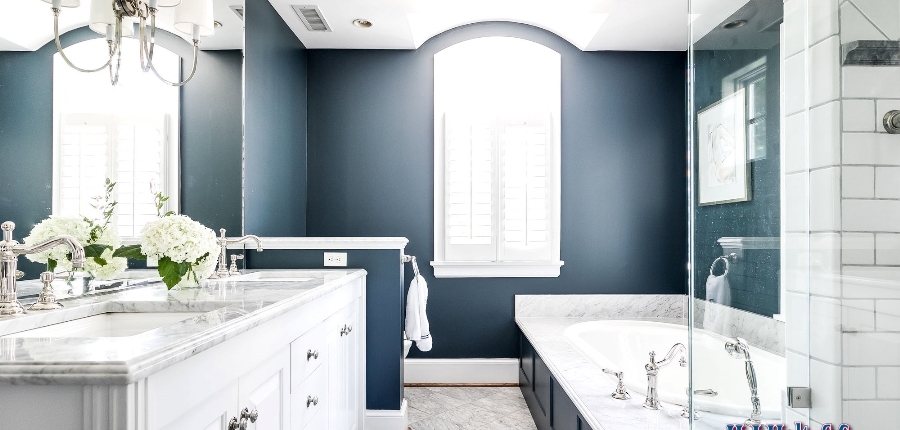
by HJ HOLTZ | Feb 14, 2023 | Residential Painting
Painted surfaces are everywhere in a home: walls, of course, but also trim, crown molding, cabinets, shelves, and ceilings. Paint can also be used on stairs, floors, and even furniture. Every time we make a paint selection for our homes, we have to select a paint sheen – or gloss level – for that paint, which affects both durability and appearance.
The best way to approach choosing a paint sheen, says Steve Preas, Benjamin Moore’s mid-Atlantic representative, is to understand the options, which may be different depending on the brand of paint under consideration. Sheens may be called flat, matte, eggshell, pearl, satin, semi-gloss, or high gloss – with flat and matte having virtually no shine and high gloss the most shine.
“There is no standard when it comes to paint sheen,” he says. “One company might say we have a matte finish, but one person’s matte finish might be somebody’s flat finish or somebody else’s satin finish.”
What is uniform, Preas says, is that each paint sheen has its own characteristics and strengths. “The higher the sheen, the more durable it will be, because it resists fingerprints, and is moisture- and scuff-resistant,” he notes. “You want to use high sheen on high-touch surfaces, like doors, cabinets, and trim.”
Ceilings often get the lowest sheen, since they aren’t routinely touched. Low-sheen paints are also useful in covering imperfections in surfaces, like dings or nail pops commonly found on walls.
“It’s about the way the light will catch the surface,” Preas says. “The glossier the surface, the more the light reflects off it and the more light will be bounced back to your eye.”
The sheen can also seemingly affect the paint color itself.
“A matte finish can make a color seem deeper, more saturated,” Preas says. “When you go up in sheen, more light is being reflected, so it can seem a little lighter than the shade selected.”
The overall brightness of a room should also factor into both shade and sheen selection, because both natural light as well as light from lamps or wall and ceiling fixtures will affect the perceived color of walls, in particular. Preas notes that the same paint color, when painted on different walls with different light exposures, can appear as mismatched hues.
“It’s a phenomenon that can drive people crazy,” Preas says. “We have customers who notice that their crown molding looks different from the other trim in the room. It’s about the tilt of the molding and how it reflects light differently.”
Paint color can also appear to change over the course of a day or across seasons – again, because of the way the light is moving. While this shifting might seem confusing, it can also help people enjoy the space.
“We have color stories – our color collections – that play up on that dynamic way that colors change throughout the day,” he says. “Some people want it to always be that green wall. But designers like a dynamic feel. A room that can feel cool in the morning but warm and cozy in the evening.”
Many of the old “rules” of household paint are now being upended, with more homeowners using color – and even high gloss paint – on ceilings for impact. In bathrooms, which historically have been painted with a shinier finish, such as satin or semi-gloss, it’s now possible to use a Benjamin Moore matte finish, AURA Bath & Spa, specifically formulated to withstand moisture.
“You don’t have to have that shiny paint,” Preas says. “You get that true color, but not the streaks that may happen.”
The bottom line, Preas says, is to answer three foundational questions at the start: What kind of paint do you want? What color of paint do you want? What sheen of paint do you want? “You have to have those questions answered before you start,” he says. “Paint is like labor; you want to make sure you have everything agreed upon from the beginning.”





